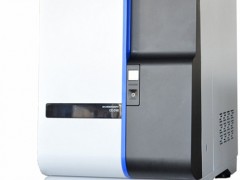As described in Technical Note KRI-01, an ion beam from a broad-beam industrial source must be neutralized. This is done by emitting electrons from a neutralizer. A hot-filament, plasma-bridge, or hollow-cathode type of neutralizer may be used. The ion source in Fig. 1 could be either gridded or gridless. For a gridless source, the neutralizer is a called a cathode-neutralizer. The target can be a sputter target or a substrate being etched. Connected to a voltmeter in Fig. 1, it serves as a neutralization probe.
RECOMBINATION
The recombination of electrons with energetic ions to obtain energetic neutrals is not a significant process at the background pressures of interest - one milliTorr or less.
SPACE-CHARGE NEUTRALIZATION
The density of electrons in a broad ion beam is approximately equal to the density of ions. In plasma physics this is called space-charge neutralization or quasi-neutrality.
As an example, consider a long, cylindrical beam of 500 eV ions, 10 cm in diameter and with a current density of 1 mA/ cm2. If no electrons were present, the potential difference between the axis and the outside surface of the beam would be over 14,000 V. Such a potential difference is clearly
Cathode-neutralizer emission, A
unrealistic for 500 eV ions. For this potential difference to be reduced from over 14,000 V to 140 V, an average of about 99 electrons would be required to space-charge neutralize each 100 ions. Experimentally, the potential in an ion beam rises when there is a deficiency of electrons. At a potential relative to surrounding hardware of roughly 200 V, small arcs occur between the beam and that hardware. These arcs supply enough electrons to keep the potential from rising further. The neutralization arcs can be seen inside the vacuum chamber as 1-2 mm long flashes of extremely short duration. If the lack of neutralization is serious, the arcs will appear almost continuously on nearby hardware, giving it a sparkling appearance. These arcs can damage work pieces. If the arcs are on hardware near the work pieces, particulates can be deposited on the work pieces.
For an ion energy of 200 eV, it is more likely that the beam would become extremely divergent, or the ion source would stop operating, before the beam potential would rise enough to create these neutralizing arcs.
In summary, for an ion source operating in a normal manner, the ion beam will be space-charge neutralized. Even if the ion beam potential is sufficient to produce neutralization arcs, the departure from equal numbers of electrons and ions in each volume would be small.
Technical Note KRI-02
CURRENT NEUTRALIZATION
Current neutralization occurs when the electron emission to the ion beam is equal in magnitude to the ion current in that beam. In a gridded source, current neutralization is obtained when the neutralizer emission equals the ion-beam current. In a gridless source, it is obtained when the cathode-neutralizer emission equals the discharge current.
The effect of cathode-neutralizer emission on target potential is shown in Fig. 2 for a gridless end-Hall ion source operated at a discharge current of 5 A. The target potential was measured as shown in Fig. 1. This potential was near ground at current neutralization (-2 V), decreased moderately for excess electron emission, and rose rapidly for insufficient emission. The target had an area of only 2 cm2 and was 30 cm from the ion source. The potential variation of the target would be larger for a target that captured more of the ion beam. Regardless of the target size, though, current neutralization results in near-optimum potentials for electrically isolated targets.
PRACTICAL ConSIDERATIONS Grounded Target, Grounded Chamber Walls
If the target is electrically conducting and grounded, the neutralization requirement is moderate. Electrons are needed only to make up for the loss of the more energetic electrons that are absorbed by nearby conducting surfaces. Secondary electrons from ion collisions with grounded surfaces help make up for this loss, but it is usually necessary to have some electron emission to avoid neutralization arcs. It is recommended that the electron emission be within 10% of current neutralization, but it is unlikely that arc-related damage would occur without a deficit greater than 50% or an excess greater than 100%.
Electrically Isolated Target, Grounded Chamber Walls
The target may be electrically isolated because it is made from a dielectric material, coated with a dielectric, or some other reason. The vacuum-chamber walls, or the sputter shields withinthosewalls,areassumedtobeconductiveandgrounded. The vacuum chamber is filled with a charge-exchange plasma (see Tech. Note KRI-03). This plasma provides an electrically conductive path from the ion beam to the walls. It is recommended that the electron emission be set between current neutralization and 10% more than this value. Any excess emission should be conducted to the vacuum-chamber walls without building up an excessive charge on the target.
Charge-Sensitive Target, Grounded Chamber Walls
This application is generally similar to the above application, except that the target is also sensitive to electrostatic charging damage [1]. As a preliminary recommendation, the electron emission should be between current neutralization and a 5% greater value. A recommended diagnostic is to measure the potential of an electrically isolated target, as shown in Fig.
1. Measuring this potential through a complete startup and shutdown cycle can be helpful in modifying procedures to reduce damage. The target potential should be maintained within 5 V of ground, or closer if damage still occurs. It may be found from the diagnostic test that a 10-20% excess electron emission can be used without causing problems. If the beam consists of oxygen ions, the use of graphite for the diagnostic target can delay its coating with a dielectric.
Dielectric Deposition, Dielectric Coated Walls
In dielectric deposition, the dielectric is often deposited throughout the vacuum chamber. As a result, the charge-exchange plasma may not be able to provide an adequate conductive path for excess electrons, and damage may result from quite small departures from optimum electron emission. The electron emission should be set within 5% of current neutralization. If there is any doubt about the accuracy of the metering, calibrate the meters (see Troubleshooting below). If possible, a grounded, conductive area of several hundred square centimeters should be provided near the ion source to contact the charge-exchange plasma. Such an area can be shadow-shielded from the deposition, or simply be a portion of the sputter shield that is replaced more often than the overall shield. If such a contact area can be maintained, it may be possible to both reduce work piece damage and increase the tolerance to excess electron emission.
Troubleshooting
If neutralization arcs and/or target damage are observed, but the operating condition appears reasonable, check the current meters against each other or against some common standard. Large discrepancies have sometimes been encountered with new equipment.
A hot-filament neutralizer must be located within an ion beam to provide adequate conductivity to that beam. Other neutralizer types are less sensitive to location. 其他產(chǎn)品
電話:+86-21-5046-3511
郵箱:ec@hakuto-vacuum.cn
地址:上海市浦東新區(qū)
新金橋路1888號(hào)36號(hào)樓7樓702室
201206
詳細(xì)資訊
 手機(jī)版|
手機(jī)版|

 二維碼|
二維碼|











